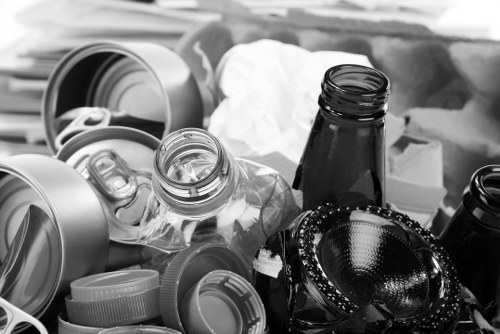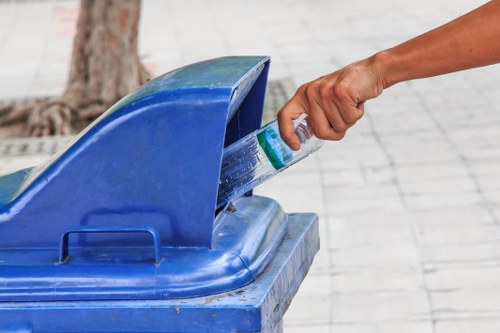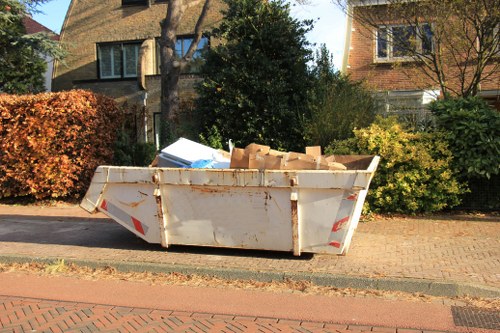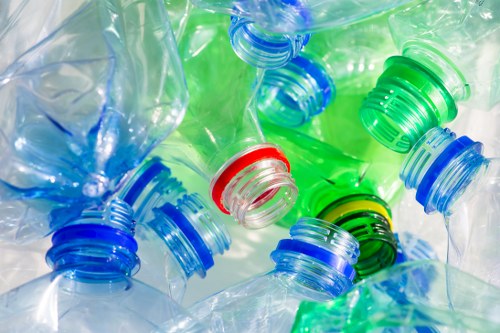Efficient Construction Waste Clearance in Catford
Understanding Construction Waste Clearance

Construction projects, whether large or small, inevitably produce a significant amount of waste. Managing and clearing this waste efficiently is essential to maintain a safe, clean, and environmentally friendly site. In Catford, a bustling area with numerous ongoing construction projects, effective waste clearance services are in high demand.
Proper construction waste clearance not only ensures compliance with local regulations but also promotes sustainability by facilitating recycling and reducing landfill usage. By partnering with professional waste clearance providers, construction companies can focus on their core activities while leaving the hassle of waste management to the experts.
In this article, we will explore the various aspects of construction waste clearance in Catford, including the types of waste generated, the importance of timely disposal, and the benefits of hiring professional services.
Types of Construction Waste

Construction sites produce a diverse range of waste materials, each requiring specific handling and disposal methods. Understanding the different types of construction waste is crucial for effective clearance and environmental compliance.
1. Demolition Waste
Demolition waste includes materials removed during the demolition of existing structures. This can consist of concrete, bricks, metals, wood, and other building materials. Proper sorting and recycling of these materials can significantly reduce the environmental impact.
2. Excavation Waste
Excavation waste is generated during the digging and removal of soil and rock. This type of waste often requires special disposal methods, especially if contaminated with hazardous substances.
3. Hazardous Waste
Hazardous waste includes materials that are flammable, corrosive, or toxic. Examples include asbestos, lead-based paints, and certain chemicals. Handling and disposing of hazardous waste requires adherence to strict safety guidelines and regulations.
Importance of Timely Waste Disposal

Timely construction waste disposal is vital for maintaining a safe and efficient construction site. Delays in waste clearance can lead to several problems, including:
- Safety Hazards: Accumulated waste can create trip hazards and obstruct emergency exits, increasing the risk of accidents.
- Project Delays: Excessive waste can slow down construction activities, leading to missed deadlines and increased costs.
- Environmental Impact: Improper disposal can lead to pollution and adverse effects on the surrounding community.
By ensuring regular and prompt waste removal, construction sites in Catford can operate smoothly, safely, and in harmony with environmental standards.
Benefits of Professional Waste Clearance Services

Hiring professional construction waste clearance services in Catford offers numerous advantages:
1. Expertise and Experience
Professional waste clearance companies have the knowledge and experience to handle various types of construction waste efficiently. They understand the best practices for sorting, recycling, and disposing of materials, ensuring compliance with local regulations.
2. Cost-Effective Solutions
Outsourcing waste clearance can be more cost-effective than managing it in-house. Professionals can optimize waste disposal processes, reducing the overall costs associated with waste management.
3. Environmental Sustainability
Professional services prioritize recycling and sustainable disposal methods, minimizing the environmental footprint of construction projects. This commitment to sustainability can enhance the reputation of construction firms in the community.
Steps in Construction Waste Clearance

The process of construction waste clearance involves several key steps to ensure effective and compliant disposal:
1. Assessment and Planning
Before commencing waste clearance, a thorough assessment of the site is conducted to identify the types and quantities of waste generated. A tailored waste management plan is then developed to address the specific needs of the project.
2. Collection and Sorting
Waste materials are collected and sorted into different categories based on their type and disposal requirements. This step is crucial for facilitating recycling and ensuring hazardous waste is handled appropriately.
3. Transportation and Disposal
Once sorted, waste is transported to designated recycling centers or disposal facilities. Professional waste clearance services ensure that all materials are disposed of in accordance with local regulations and environmental standards.
4. Documentation and Reporting
Proper documentation of waste disposal is maintained to provide compliance records and transparency. This documentation is essential for regulatory purposes and for maintaining accountability.
By following these steps, construction waste clearance in Catford can be carried out efficiently, safely, and sustainably.
Choosing the Right Waste Clearance Partner
Selecting the right construction waste clearance partner is critical for the success of any construction project. Here are some factors to consider when making your choice:
1. Reputation and Reviews
Research the company's reputation by reading reviews and testimonials from previous clients. A reputable provider will have a track record of reliability and quality service.
2. Range of Services
Ensure the waste clearance company offers a comprehensive range of services tailored to your specific needs, including recycling, hazardous waste handling, and timely disposal.
3. Compliance and Certifications
Verify that the company complies with all local regulations and possesses the necessary certifications for waste management. This ensures that your project adheres to legal standards.
4. Pricing and Contracts
Compare pricing structures and contract terms to find a provider that offers value for money without compromising on service quality. Transparent pricing helps avoid unexpected costs down the line.
5. Sustainability Practices
Choose a company that prioritizes sustainability and environmentally friendly practices. This commitment not only benefits the environment but also enhances your project's green credentials.
By carefully evaluating these factors, you can select a construction waste clearance partner in Catford that meets your project's requirements and supports your sustainability goals.
Environmental Impact of Construction Waste
Construction waste management plays a significant role in environmental conservation. Improper handling and disposal of waste can lead to various environmental issues:
- Landfill Overuse: Excessive construction waste contributes to the rapid depletion of landfill space, leading to increased environmental strain.
- Pollution: Improper disposal can result in soil and water contamination, affecting local ecosystems and human health.
- Resource Depletion: Failure to recycle and reuse materials leads to the unnecessary extraction of natural resources, exacerbating resource shortages.
On the other hand, effective construction waste clearance promotes recycling and reuse, reduces landfill dependency, and minimizes the overall environmental footprint of construction activities.
Innovative Solutions in Waste Clearance
1. Recycling Technologies
Advancements in recycling technologies have transformed the construction waste landscape. Modern facilities can process a wide range of materials, turning waste into valuable resources for new projects.
2. Waste-to-Energy Conversion
Some construction waste can be converted into energy through processes like incineration, providing a renewable energy source while reducing waste volume.
3. Digital Waste Management Systems
Digital platforms and software solutions enable construction managers to track and manage waste more effectively, ensuring timely disposal and maximizing recycling efforts.
4. Sustainable Building Practices
Incorporating sustainable building practices, such as modular construction and prefabrication, can significantly reduce the amount of waste generated on site.
These innovative solutions are shaping the future of construction waste clearance, making it more efficient, sustainable, and environmentally friendly.
Regulations and Compliance
Adhering to local regulations and compliance standards is paramount in construction waste clearance. In Catford, specific guidelines govern the handling, transportation, and disposal of construction waste to ensure environmental safety and public health.
1. Local Authority Regulations
The local authorities in Catford have established regulations that mandate proper waste management practices. These regulations cover aspects such as waste segregation, storage, and disposal methods.
2. Environmental Protection Laws
National environmental protection laws also apply to construction waste clearance. These laws aim to minimize the environmental impact of construction activities through strict waste management protocols.
3. Health and Safety Standards
Health and safety standards require construction sites to manage waste in a way that protects workers and the public from potential hazards associated with construction debris.
Compliance with these regulations is not only a legal obligation but also a moral responsibility to safeguard the environment and community well-being.
Cost Factors in Waste Clearance
The cost of construction waste clearance in Catford can vary based on several factors. Understanding these cost elements can help in budgeting and selecting the right service provider.
- Volume of Waste: The amount of waste generated directly impacts the cost. Larger volumes require more resources and time for clearance.
- Type of Waste: Hazardous or complex waste types may incur higher disposal fees due to specialized handling requirements.
- Frequency of Clearance: Regular waste clearance services may offer discounted rates compared to one-time pickups.
- Transportation Distance: The distance between the construction site and the disposal facility can affect transportation costs.
- Recycling and Disposal Fees: Costs associated with recycling materials and final disposal in landfills contribute to the overall expense.
By evaluating these factors, construction companies can better estimate waste clearance costs and choose a service that aligns with their budget and project needs.
Future Trends in Construction Waste Clearance
1. Increased Automation
The integration of automation and artificial intelligence in waste management is set to revolutionize construction waste clearance. Automated sorting and processing can enhance efficiency and accuracy in waste handling.
2. Circular Economy Models
Adopting circular economy models encourages the reuse and recycling of materials, reducing the dependency on raw resources and minimizing waste generation.
3. Green Certifications
Obtaining green certifications can become a standard requirement for construction projects, driving the adoption of sustainable waste clearance practices.
4. Collaborative Waste Management
Collaborative approaches among stakeholders can lead to more effective waste management strategies, sharing resources and expertise for better outcomes.
These trends indicate a shift towards more sustainable, efficient, and technologically advanced construction waste clearance practices, positioning Catford as a leader in environmental stewardship.
How to Get Started with Waste Clearance
Embarking on effective construction waste clearance involves several key steps:
- Assess Your Waste Needs: Evaluate the types and quantities of waste your project will generate.
- Research Service Providers: Look for reputable waste clearance companies in Catford with proven track records.
- Request Quotes: Obtain detailed quotes to understand the cost implications and service offerings.
- Create a Waste Management Plan: Develop a comprehensive plan outlining waste handling, sorting, recycling, and disposal processes.
- Implement and Monitor: Execute your waste management plan and regularly monitor its effectiveness to ensure compliance and efficiency.
Taking these steps will help you establish a robust construction waste clearance system that supports your project's success and environmental responsibilities.
Conclusion
Construction waste clearance is a critical component of any construction project, ensuring safety, compliance, and environmental sustainability. In Catford, where construction activities are prominent, partnering with professional waste clearance services can streamline operations and promote greener practices.
From understanding the types of waste generated to navigating regulations and embracing innovative solutions, effective waste management requires careful planning and execution. By prioritizing construction waste clearance, construction companies can contribute to a cleaner, safer, and more sustainable community.
Contact us today to learn more about our construction waste clearance services in Catford and how we can support your next project.